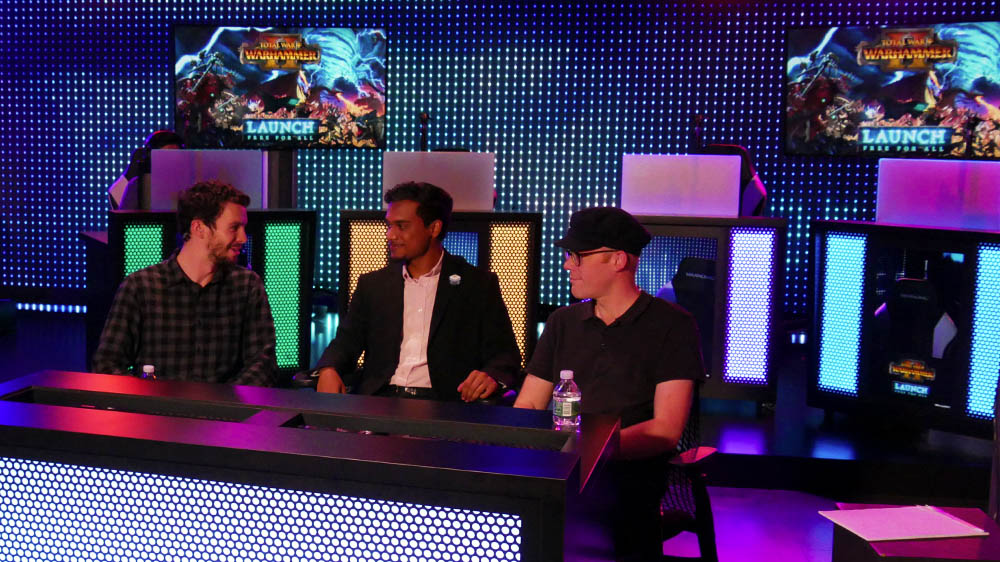The highly anticipated Total War: Warhammer II—the second game in an epic trilogy that combines the deep strategy of the Total War series with the fantasy world of the Warhammer franchise—was released on Thursday. In the tradition of both franchises, the launch was marked by plenty of blood and chaos on the field of battle.
Sega and English game developer Creative Assembly hosted a pre-launch livestream event the night before at the Mixer Studio, located at the flagship Microsoft Store on Fifth Avenue in New York City. Eight of the best Warhammer players—four in-studio, four online—assembled to compete live in a broadcast studio designed for competitive gaming.

According to Al Bickham, communications manager at Creative Assembly, Mixer Studio are big Warhammer fans, and they reached out to Sega to coordinate a pre-launch broadcast. This gave Creative Assembly a chance to show off its revised free-for-all multiplayer mode, where four players battle each other simultaneously in chaotic combat using swords, spells, dragons and dinosaurs.
James Given, Creative Assembly’s outreach and community development manager, introduced the tournament as “absolute chaos in a bottle” during the broadcast. He wasn’t kidding. Player Indypride (@milkandcookiesTW) took home the trophy in an upset victory, where he launched a sneak attack on two players locked in battle using an army of rats.
Just as the game is the perfect hybrid of two franchises, the pre-launch event simultaneously promoted two brands. While the broadcast mainly promoted the launch of Warhammer II, it also served to showcase Mixer Studio’s capabilities.
“It’s got all the equipment and infrastructure you need to do something of this scale,” Bickham said. “More importantly, there’s an awesome team behind it. Combined, they have hundreds of years of broadcast experience, and these things are complex. There are loads of stages and interstitial sweeps of graphics. They’ve put together a tremendous production from start to finish.”
Given added that the location, which was a few blocks away from Central Park, made the Mixer Studio the ideal place to hold an event. But he also agreed that being in a studio that’s purpose-built for livestreaming made a huge difference.
“Other studios that do online broadcasting are kind of a hodgepodge—they weren’t built for this sort of thing, but grew into it,” Given said. “Just getting in and out has been absolutely easy, and when you put together a broadcast like that, anything that looks easy is usually not and was paid for with a lot of blood, tears and long hours.”
Given also said that what set Mixer apart from other livestreaming platforms such as Twitch or YouTube is its interactive features, including a chat and multiple-choice trivia question showing real-time results. Given continued that Mixer, being a newer platform, was pushing the boundaries of interaction, while more established platforms were refining their approaches.

“The interaction is the key thing on Mixer,” said Given. “Audience interaction is a key thing that other platforms are pushing for but haven’t quite reached the same level. That’s something that Mixer has over everyone else.”
Leading up to the event, Bickham said that Creative Assembly reached out to its fans through social media, particularly Facebook and Twitter, while community managers engaged with fans on the Total War subreddit and other channels.
Given, who helped assemble the players for the tournament, emphasized working with influencers. Fans wanted to see these personalities battle it out and crown the best, and using influencers and social media to inform audiences about the event through word-of-mouth was critical.
However, Given added that influencers weren’t simply chosen because of their large followings. For example, Indypride probably has one of the smallest channels of the group, but he made a name for himself by offering deep analysis of Warhammer multiplayer videos.
“When you work in a studio, you’re looking for that top quality content,” said Given, referring to the players. “Something that will engage fans and looks flashy and hits all the selling points. That’s something [Indypride] did very well, and a lot of these guys are big personalities on Twitch.”
These players include BurkBlack, who describes himself as “The Pirate of Twitch” and dresses the part with the addition of a steel gauntlet. Given said that the inclusion of the Warhammer fantasy brand brought new personalities and streamers to the Total War community.
“Warhammer has opened a lot of doors for us,” Given explained. “We make historical strategy games, and a lot of people love history, but they might not like all types of history. Some might not like it at all. But when fantasy comes into it, it opens that door and loads of people want to jump in and play. Total War: Warhammer I and II have opened the way for a lot of people to stream us—people who we haven’t been in contact with before.”
As exciting as multiplayer matches can be, Given believes that the single-player campaign may be one of the most attractive aspects for influencers because of its narrative structure. He talked about how one steamer dressed up as a rat and role-played while playing the entire Warhammer I campaign on the hardest difficulty. Another used the High Elf faction as the way he believed an actual High Elf would play. The single-player campaign, with its multiple objectives and somewhat predictable pacing, make it possible for more entertaining experiences.
“All of these things mean it’s very watchable for audiences,” said Given. “In some cases, things happen that throw them off completely, and then they get advice from chat on what to do. But you should never do what chat says, because they’re always wrong.”
🔴 Live now! Tune in for our pre-launch party! Interviews and battles and more! #MicrosoftNYC
➜ https://t.co/8oDSI8fqGX pic.twitter.com/JOqrLs9TeO
— Total War (@totalwar) September 27, 2017
Although fantasy has opened many doors for Creative Assembly, it did come with its share of challenges—especially when considering how the Warhammer universe has a large variety of races and factions, accompanied by a ton of lore that newcomers might find intimidating. To underscore the point, Bickham went into detail about the new Skaven faction—a race of ruthless humanoid rats—in an interview before the tournament.
“You’ve got a dual problem to solve,” said Bickham. “One is that [Total War] is a relatively complex and deep real-time strategy game. The other is that we’re dealing with a whole universe of characters, monsters and different races. So, we try to roll that out by doing a lot more storytelling in Warhammer II than we did in the first game. Each race that you play has its own series of cut scenes and introduction videos to show the races and characters, along with the character of the races.”
Meanwhile, Creative Assembly worked with the UK-based research company Player Research and used biometrics to improve the game’s tutorial and make it more approachable to new players.
Bickham said that Total War: Warhammer II will release its first free update in just a few weeks, which will engage players as the studio continues to grow the world and build toward the third part of the trilogy. Their goal: to combine all parts to make the biggest strategy game in the world.

